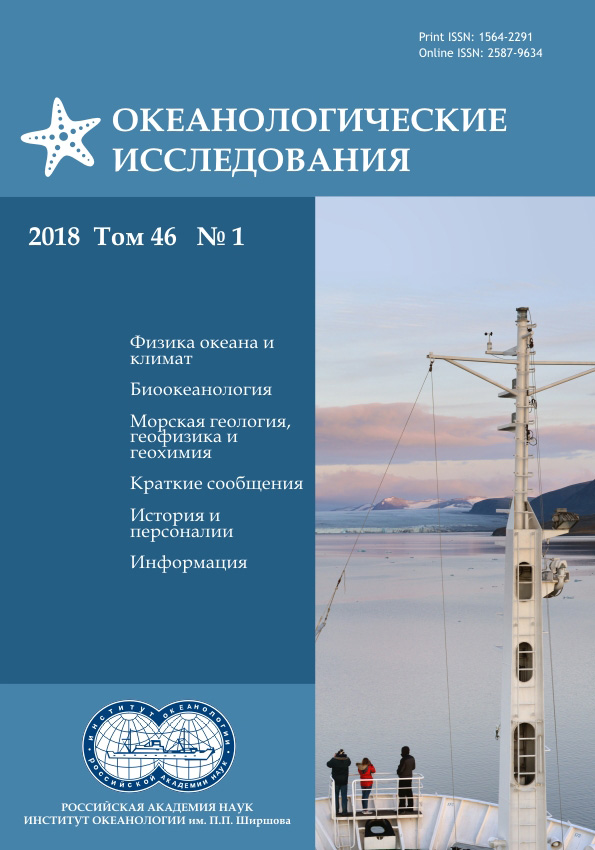ВНУТРЕННИЙ ПРИЛИВ НА ПЛАТО САНТОС
Аннотация
Мы анализируем внутренние приливы на Плато Сантос в Южной Атлантике. Исследование основано на измерениях температуры и течений на линии буев по нормали к побережью Южной Америки, в широтном диапазоне между 28°S и 31°S. Буи были выставлены на расстояниях от 25 до 888 км (от 500 м изобаты) к юго- востоку от континентального склона. Приборы были установлены на глубине 900 м. Численное моделирование выявило свойства внутренних приливов (амплитуды, длину волны и уменьшение энергии) вдоль линии их распространения от континентального склона. Амплитуды внутреннего прилива уменьшаются от континентального склона в направлении к каналу Вима от 36 м до 15 м. Плотности энергии приливных внутренних волн вычислялись из полусуточных приливных компонент временного ряда течений и температуры с учетом вертикальных градиентов температуры и частоты Вяйсяля- Брента. Затухание энергии внутреннего прилива соответствует обратному степенному закону. Численное моделирование генерации и распространения внутренних приливов показывает, что вблизи континентального склона образуются лучи внутренних приливов. Затухание энергии по результатам численного моделирования соответствует данным измерений.
Литература
- Egbert G.D., Erofeeva S. Effici ent inverse modeling of barotropic ocean tides // J. Atmos. Ocean Tech. 2002. Vol. 19. P. 183–204.
- Holloway P.E., Merrifield M.A. Internal tide generation by seamounts, ridges, and islands // J. Geophys. Res. 1999. Vol. 104 (C11). P. 25,937–25,951.
- Lozovatsky I.D., Morozov E.G., Fernando H.J.S. Spatial decay of energy density of tidal internal waves // J. Geophys. Res. 2003. Vol. 108 (C6). P. 3201–3216.
- Morozov E.G. Semidiurnal internal wave global field // Deep-Sea Res. 1995. Vol. 42 (1). P. 135–148.
- Morozov E.G., Vlasenko V.I. Extreme tidal internal waves near the Mascarene Ridge // J. Marine Sys. 1996. Vol. 9 (3–4). P. 203–210.
- Morozov E.G., Demidov A.N., Tarakanov R.Yu. Transport of Antarctic waters in the deep channels of the Atlantic Ocean // Doklady Earth Sciences. 2008. Vol. 423 (8). P. 1286–1289.
- Morozov E.G. Oceanic Internal Tides, Observations, Modeling and Analysis. A Global View. Dordrecht: Springer, 2018. 316 p.
- Pereira A.F., Castro B.M. Internal tides in the Southwestern Atlantic off Brazil: Observations and numerical modeling // J. Phys. Oceanogr. 2007. 37 (6). P. 1512–1526.
- Speer K.G., Zenk W. The flow of Antarctic Bottom water into the Brazil Basin // J. Phys. Oceanogr. 1993. Vol. 23. P. 2667–2682.
- Torgrimson G.M., Hikecy B.M. Barotropic and baroclinic tides over the continental slope and shelf off Oregon // J. Phys. Oceanogr. 1999. Vol. 9. P. 945–961.
- Vlasenko V., Stashchuk N., Hutter K. Baroclinic Tides: Theoretical Modeling and Observational Evidence // Cambridge: Cambridge Univ. Press, 2005. 351 p.
- WOD13 (2013) World Ocean Database 2013, Geographically Sorted Data,https://www.nodc.noaa.gov/OC5/WOD/datageo.html; last updated October 26, 2013; last accessed in October 2017.
Передача авторских прав происходит на основании лицензионного договора между Автором и Федеральным государственным бюджетным учреждением науки Институт океанологии им. П.П. Ширшова Российской академии наук (ИО РАН)













